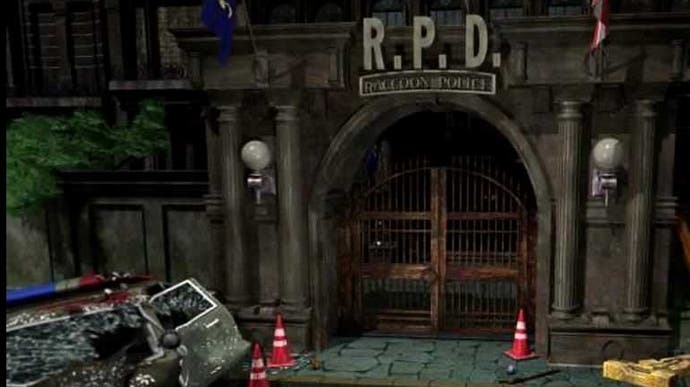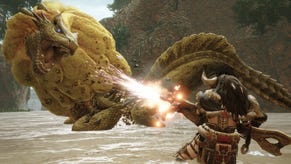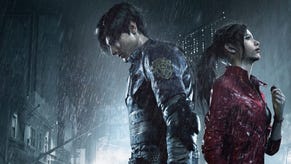The many selves of Resident Evil 2's police station
Map scream.
Is it possible for a building to haunt itself? Resident Evil 2's remake suggests so. While wandering the new game's extravagantly remodelled police station I've been dogged by the thought that older incarnations of the structure are trying to force themselves into the light. It's not just that the station used to be an art museum within Resident Evil's fiction - a kludge dreamed up by original scenario writer Noboru Sugimura to explain the eerie marble busts, emblem doors and oil paintings that sit alongside the gun cabinets and mounds of paperwork. It's that so many other evils have resided here since the original game rocked PlayStations in 1998.
The absurdly overwrought entrance lobby, in particular, has graced no less than five games, from Resident Evil 3 through online multiplayer curio Outbreak to the much-reviled Operation Raccoon City, all orbiting roughly the same point in the series chronology. Google "Raccoon City Police Station" and you'll be treated to a phantasmagorical, algorithmic mishmash of interiors from these titles - the military vibe of the abandoned "Resident Evil 1.5" sutured to Resi 3's gentle rearrangement from 24 hours before the events of Resi 2. All this, and then you remember that there are multiples of the station even within Resident Evil 2 itself. Among both the 1998 game and the remake's more ambitious features is "zapping", in Hideki Kamiya's bouncy phrase, a parallel story mechanic in which each protagonist tackles the same layouts with different enemy and item arrangements.
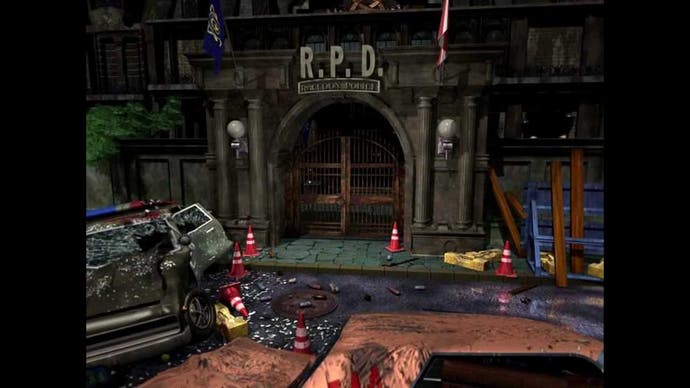
Approaching the remake as a veteran of these titles, you can almost feel the station's many reinventions swirling around your ankles like ectoplasm, running their fingers through Leon's bangs. One of the new game's best qualities - providing you skip the spoilery trailers - is that it keeps you guessing about where it clings to that legacy and where it strays. This creates obvious practical problems for a returning player: it means that your knowledge of prior layouts can be used against you by the designers. The Licker's newfound ability to scuttle over walls and ceilings may be alarming, allowing it to exploit the abundance of dark corners created by an over-the-shoulder camera and a flashlight. But the bigger problem is that the Licker isn't quite where you left it. Nor, for that matter, is the shotgun that used to be your best friend in a close encounter. Beyond that, there's something to the process of revisiting this much-revisited space that evokes Sigmund Freud's concept of the uncanny or "unheimlich" - that which frightens because it is strangely familiar. It's satisfying to trace the design of previous RPD stations in the remake - puzzles have been broken apart and elaborated upon, rooms mutilated and transplanted - but there's also a feeling of disorientation and unease, of fumbling at the contours of something repressed.
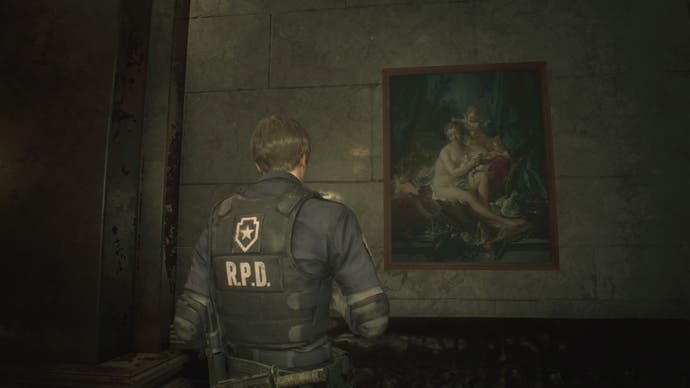
Stepping into the reception area, I circle automatically to avoid a war memorial the developers have already moved out of the way. Walking to the rear of the lobby I'm jarred to find that there's no longer an emergency ladder to the floor above, the second storey being accessible by stairs from the get-go. Everywhere I go I am pestered by the spectre of what was, glimmering within surfaces like the circuits exposed by Ada Wong's hacker pistol. The police station is, of course, literally an exercise in concealing another structure in that it's the gateway to a bioweapons laboratory. The building's spatial and decorative flourishes also have an explicit psychological resonance in how they mirror the mind of RPD chief Brian Irons, who is responsible (well, per some backstory documents written after the associated assets were created) for many of the stranger artefacts you'll stumble on.
The building is dotted with works of neoclassical sculpture, a parade of clean, symmetrical, quasi-mythical figures done up in spotless white marble. What a contrast to the other, decidedly impure bodies that shamble about the halls of the RPD. The irony is heightened by the very uncanny grisliness of the original puzzles, many of which resemble acts of butchery or surgery. There are jewels called "virgin hearts", to be plugged into the breasts of stone maidens, and stone heads you must shove onto pressure panels. If the puzzle aesthetic venerates the human form, the act of solving those puzzles reveals flesh for flesh, never more than the sum of parts you are free to recombine. Sadly, the remake dials this queasy implication back: with many years of franchise development under its belt, it would rather eschew metaphors and find empirical rationales for the 1998 game's flights of fancy. The chesspiece puzzle, for instance, now has an (admittedly quite amusing) in-game explanation.
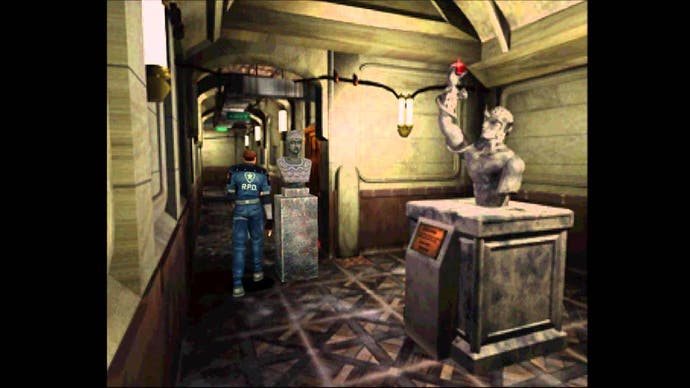
The remake does, however, quietly intensify another quality of the original puzzles - the suggestion that all those door emblems, statues and gemstones lock together into a massive, over-arching ritual. One of the statue conundrums in the 1998 game refers to reviving "Tyranos", a possible misspelling of "tyrant" in Greek. Tyrant, of course, is the codename for Umbrella's nastiest creations, amongst them the illustrious Mr X. In solving this puzzle, there's the thrilling thought that you aren't merely opening the path to the lab but summoning its creatures to the surface. I won't spoil it, but the remake plays this up by recentralising much of the puzzle design on the lobby. On the one hand this makes backtracking between puzzle piece locations more elegant, or at least, more in keeping with the hub structures we're accustomed to in younger games. On the other, it creates the vague sense of powering up some kind of colossal occult centrifuge, piece by piece.

The uncanniness of Resident Evil 2's much-reincarnated police station reflects something fundamental about buildings in general, most destined to outlive their architects (Sugimura passed away in 2005) and assume new dimensions in the hands of others. You'll never step into the same river twice, according to Heraclitus: this seems equally true of the places we live and work in, all subject to different needs from year to year, hollowed out and mutated by successive occupants. Every building has the capacity to be a little ghostly. To pick a grander example, London's Tate Modern museum was once a power plant, and there are moments, standing in that cavernous entrance hall, when you can almost hear the missing turbines thrum.
Perhaps every videogame remake is a little ghostly too, depending on what you bring to it. Much as Resident Evil's police station has been reinvented from game to game, so our understanding of even the original layouts has shifted as new ideas of play have come into circulation. There is the police station I recall from my teens in the dial-up era - a series of blindspots in which I am always on the backfoot, always a bullet shy of the rough quantity needed to put down a zombie. But there is also the station I know from Youtube speedruns, in which most ammo drops are spurned and the zombies might as well be traffic cones. The achievement of Capcom's remake, whatever my occasional misgivings, is that it adds another, fresh layer of understanding to a building that is not so much a space as a tradition, spanning many artworks and eras. Far from merely updating and finalising the station, rendering its previous selves obsolete, it is another way of thinking about an amazing place.
